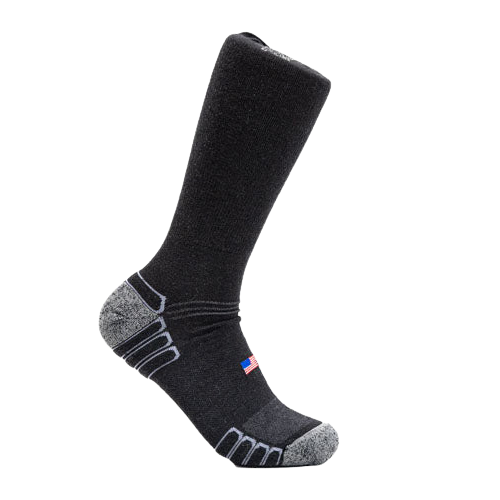Do you have a trusty pair of work boots you’re looking to take with you on the trail?
Good news: in many situations, a pair of work boots will do just fine for a hike. But there are some important differences to note when comparing hiking boots vs work boots.
If you’re thinking about going hiking more than once a year, get all the details on how to take care of your feet, both at work and in the mountains.
We’ll break down exactly why hiking boots perform better in nature and why work boots can be a real blessing in a hard-day’s labor.
What’s the Difference Between Hiking Boots and Work Boots?
So do you really need to get a new pair of boots to go on a hike?
As we’ll see, hiking boots offer some big advantages on the trail, and nothing quite works like a sturdy work boot when you accidentally drop a brick on your foot.
Here are the major differences between the two styles.
Traction
Both hiking boots and work boots are similar in that they feature lug soles, but if you look closer, you'll see the shape and construction are much different.

The rubber lug soles on each are slip-resistant and hold up well to rain, snow, and icy conditions. But with hiking boots, most brands have odd patterns that almost seem random. This variation can be a literal lifesaver when you’re on uneven ground.
It’s especially helpful when you’re scaling rocks and boulders, as there are far more points-of-contact at any given moment.
That said, most work boots have a lot of traction and they’ll do just fine in most hiking conditions.
If you plan on hiking every few months and you want to make sure you’re prepared for any condition---whether it’s crumbling rocks or slimy algae as you cross through a river---the added traction a hiking boot offers is a safe bet.
Now, not every hiking boot has the same sole as the one pictured above, but the principle holds. The more random the patterns on the bottom, the better the grip in slippy-situations.
Durability
As with any boot, you get what you pay for. A cheap version of either boot won’t last long. But both hiking boots and work boots are designed to withstand harsh treatment, and quality brands will hold up to rigorous use.

That said, harsh treatment comes in many forms and each style has its strengths and weaknesses.
Weight
The downside to steel-toe boots is that they’re heavy, and that can be problematic for hikers. It may not feel difficult to lift your foot, but as the miles add up, a few extra ounces of weight can wear a hiker down.

If your job requires you to be on your feet all day, but you don’t need to regularly handle heavy objects (package delivery drivers, municipal waste workers), a hiking boot can be an excellent workwear solution. Yes, you might not get the added top-of-foot protection, but the added versatility is nice if hiking is an occasional hobby.
Flexibility
Have you ever stepped on a nail while wearing a work boot? If you have, chances are the nail didn’t reach your foot.
That’s because work boots are built with thick, stiff rubber soles. While the thickness is great for protecting the bottom of your feet, it’s not the most flexible or comfortable.
Most hiking boots have an EVA foam insole with a slip-resistant and water-proof rubber outsole.

EVA foam is light and flexible. Beyond that, it gradually conforms to the wearer’s foot, so your shoes will become more comfortable as you put more miles in.
While EVA doesn’t handle punctures as well as pure rubber, it’s much better at absorbing the impact if you step on a sharp rock. More flexibility equals more stability. If you’re worried about your ankles, you’ll want something that can roll with the punches. Hiking boots have that extra bit of give.
Also, many work boots contain steel shanks. This increases the protection and support but makes the boot much stiffer. Hiking boots usually have a TPU insert, which is a form of plastic---it’s much lighter than steel while still offering a lot of arch support.
Should You Go Hiking in Work Boots?
Short answer: one hike is ok with work boots, but if you’re planning on two hikes, you’ll want to invest.
If you’re thinking about going on a hike and you only have a pair of work boots, you’ll be fine. Yes, your feet may be a little extra sore at the end because of the added weight and lack of flexibility, but you won't do any permanent damage.

But if you’d like to go on a few hikes throughout the year, picking up a pair of hiking boots is worthwhile. The added safety and comfort will just make your hobby even more enjoyable.
If you’re hiking in an area with nearby water, like a stream, river, or waterfall, and you think you may have to cross a few times, you’ll be thankful you were wearing breathable hiking boots instead of clunky work boots. Once you get your work boots wet, the smell can be powerful and the car ride home might not be fun.
And even though both styles offer a lot of traction, the unique patterns on the bottom of hiking boots have an edge in uneven, unpredictable terrain. In most scenarios, it won’t make too much of a difference, but I think any scrap of safety and protection you can get yourself when heading into nature is always worth it.
Ready to Lace Up and Hit the Trails?

If you see yourself going on a hike more than once, consider picking up a specialized boot.
You may not get as much use out of them as your work boots, but your hiking boots won’t break down in your closet. They’ll be ready to go every time you get the urge to head out into nature.
To us, the breathability, traction, flexibility, and weight make a dedicated hiking boot a must if you’re picking up the hobby.
And don't forget to get the right socks for the job, too. The Camel City Mill Boot Wool Work Sock is perfectly suited for hiking because it's sweat wicking, durable, and has padding in all the right places,
So what do you think? Is there a special boot for every occasion? Or will any boot do?






